| Reviews & Columns |
|
Reviews DVD TV on DVD Blu-ray 4K UHD International DVDs In Theaters Reviews by Studio Video Games Features Collector Series DVDs Easter Egg Database Interviews DVD Talk Radio Feature Articles Columns Anime Talk DVD Savant Horror DVDs The M.O.D. Squad Art House HD Talk Silent DVD
|
DVD Talk Forum |
|
|
| Resources |
|
DVD Price Search Customer Service #'s RCE Info Links |
|
Columns
|
|
|
Looney Tunes - Golden Collection, Volume Five
THE SHOW:
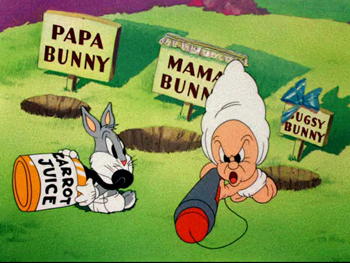
It must almost be Christmas again, because I've got another collection of old Warner Bros. cartoons to watch! Looney Tunes - Golden Collection, Volume Five continues the annual tradition of releasing a smorgasbord of classic cartoon shorts on DVD. Four discs, 15 cartoons on each, with plenty of extras to go along with it. Though many would hope for a larger collection or character-themed sets a la the Disney Treasures, these Golden Collections seem to me like an efficient way to deal with a gargantuan back catalogue, covering plenty of bases in a more affordable package than split sets would allow.
As it is, Looney Tunes - Golden Collection, Volume Five has a different theme for each DVD, just as the first four volumes did. So, as you work your way through the box, you aren't just getting random cartoons hurled at you, there is a sense of programming at work here.
Plus, these sets are the only way to currently see these wonderful old cartoons (Merrie Melodies are represented, too) in their original condition, with all of the racey (and sometimes racist) jokes intact, not cleaned up for television and mass consumption by children. These comedy films were always intended to be just as appealing to older viewers, and fans of the art form like myself tend to prefer to see them as they were originally shown. We're smart enough to do our own clean-up, thanks.
Where we do want the studios to do the cleaning for us, actually, is in the picture presentation. The cartoons on Looney Tunes - Golden Collection, Volume Five are not all perfect. There are sometimes scratches or blips of debris on the image, but for the most part, they have all been transferred to digital from solid masters. In any case, they are light years better than syndicated television versions or faded VHS tapes. While I am sure a lot of us would love to see old cartoons given the full restoration treatment the way many old films are, I just don't see that happening, and until it does, the Golden Collections are the best game in town.
Anyway, enough of the overall impressions. Without further ado, let's look at the actual DVDs...
***DISC 1: Bugs Bunny and Daffy Duck***
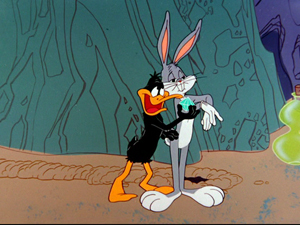
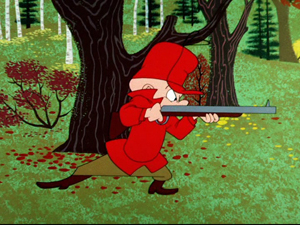
Bugs Bunny is pretty much a given for any set. These fifteen cartoons actually tend to lean a little more toward Daffy, which is fine by me, since I am a bigger Duck fan than Rabbit fan. Both characters get a handful of solo shorts, and then there are a few team-ups, such as "A Star is Bored," where Daffy acts as Bugs' stand-in on the set of his latest 'toons, or "The Abominable Snow Rabbit," one of the many where the traveling pair takes a wrong turn and ends up far away from their original destination. In this case, they land in the frozen forests of the Himalayas, and they run afoul of an Of Mice and Men-inspired snow creature who wants a rabbit of his very own. Many gags are rolled out involving Bugs tricking Daffy into tricking the Snowman into thinking that Daffy is actually a Bunny.
"The Abominable Snow Rabbit," like many of the shorts on DVD 1, was directed by Chuck Jones, and it is evidence of his and cohort Maurice Noble's more caricatured style. This disc is actually split pretty evenly between 'toons helmed by Jones, Friz Freleng, and Robert McKimson. The one exception is "The Stupor Salesman," which is directed by Art Davis. It stars Daffy as a traveling salesman who picks a fugitive from the law as his mark and tries to sell the reluctant thug all sorts of doo-dads he doesn't need.
"The Stupor Salesman" is pretty indicative of the Daffy solo shorts: the bird is cast in some occupation or scheme where he persistently pursues his goal without ever having the self-awareness of just how inept he is. Thus, the constantly unhelpful hero in the Superman parody "Stupor Duck" or the gumshoe who has a lot of theories, all of them wrong, in the excellent noir spoof "The Super Snooper."
As for the Bugs shorts, they are often more about exotic locales, like the far east of "Ali Baba Bunny" or the Drac-tastic "Transylvania 6-5000." They make for a solid lead-in for the set, boasting lots of laughs and representing the trademark Looney Tunes style.
The full list of cartoons on DVD 1, with commentaries and alternate audio tracks indicated:
* 14 Carrot Rabbit * Ali Baba Bunny (commentary by filmmaker Greg Ford/Music-Only Audio Track) * Buccaneer Bunny * Bugs' Bonnets * A Star is Bored * A Pest in the House (commentary by writer Paul Dini) * Transylvania 6-5000 (commentary by historian Jerry Beck) * Oily Hare * Stupor Duck (Music-Only Audio Track) * The Stupor Salesman (Music-and-Effects-Only Audio Track) * The Abominable Snow Rabbit (Music-and-Effects-Only Audio Track) * The Up-Standing Sitter * Hollywood Daffy * You Were Never Duckier (commentary by director Eric Goldberg)
***DISC 2: Fun-Filled Fairy Tales***
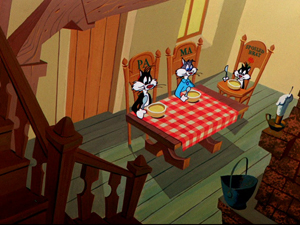
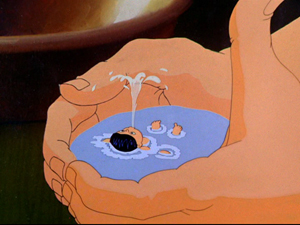
The Warner Bros. gang regularly used well-known stories as fodder for comedy in their cartoons. As pointed out in the "Inside Look" on this disc, a mini-documentary relating to this set of cartoons, they quite regularly recycled the same fairy tales, and so on here you will see multiple versions of "The Three Bears" and "Red Riding Hood" alongside their askew takes on "Hansel & Gretel," "The Pied Piper," "Cinderella," and others.
There are three basic approaches to these old stories: insert a popular character into the tale (Bugs Bunny meets Hansel and Gretel in "Bewitched Bunny," Porky Pig is the Pied Piper in "Paying the Piper"); create original versions that fit the Looney Tunes aesthetic (the family of bears in "The Bear's Tale," the gangster-esque wolf in "The Trial of Mr. Wolf"); or do a "clip show," running through multiple tales in a rapid-fire one-off gag fashion ("Foney Fables," "A Gander at Mother Goose"). These are generally fun cartoons, and though I originally wondered if it wouldn't have been better to arrange them in chronological order, I ended up liking that they were arranged by story so that we see alternate versions of the same tale back-to-back, allowing us to compare and contrast. For instance, "Little Red Walking Hood" pits a hustler wolf against his little girl nemesis, and it's immediately followed by "Red Riding Hoodwinked," which adds Tweety and Sylvester to the regular wolf and Red mix. Warners also links similar approaches. "Goldimouse and the Three Cats" and "Little Red Rodent Hood" are both Sylvester vehicles with the cat in place of the bears and the wolf from the fairy tales and mice versions of the damsels in distress, and both "The Trial of Mr. Wolf" and "The Turn-Tale Wolf" get Big Bad's side of the story of the Red Riding Hood and Three Little Pigs scenarios. Thus, these are paired together.
There are two outside exceptions to the three techniques I noted. One is the overly cute "Tom Thumb in Trouble," a rather straight little story from Chuck Jones' early Disney-influenced period. In this short, Tom gets himself into some trouble, and a little bird helps him out of it. Tom's regular-sized father mistakes the bird's helping hand for an attack, and then Tom tries to save the bird in turn. The animation style is more realistic, and the overall story a little sugary.
Rounding out the disc is a cartoon I'm not sure I've ever seen before, "Señorella and the Glass Huarache." Directed by Hawley Pratt, this 1964 film is considered the last Looney Tune, with Warner Bros. closing the animation department prior to its release. The opening logo and music is different than the classic model, taking a more poppy '60s tack (it was originally created for Chuck Jones' "Now Hear This"). The animation follows suit, borrowing some of the stylization from '50s Chuck Jones but with a lot less detail and not as well-drawn. The story is a Mexican retelling of Cinderella, including many cringe-inducing silly jokes relying on caricatures of Mexican accents and a less-than-enlightened view of the culture. Even so, there are some funny gags, and the structure of the piece is excellent. An odd choice to close the disc, though, inspiring more of a "Huh?" than the belly laugh we'd normally expect from a Looney Tunes comedy.
The full list of cartoons on DVD 2:
* Bewitched Bunny (commentary by director Eric Goldberg/Music-and-Effects-Only Audio Track) * Paying the Piper * The Bear's Tale * Foney Fables * Goldimouse and the Three Cats (Music-Only Audio Track) * Holiday for Shoestrings (commentary by historian Daniel Goldmark) * Little Red Rodent Hood * Little Red Walking Hood (commentary by animator Mark Kausler) * Red Riding Hoodwinked (commentary by filmmaker Greg Ford with director Friz Freleng/Music-Only Audio Track) * The Trial of Mr. Wolf * The Turn-Tale Wolf (Music-and-Effects-Only Audio Track) * Tom Thumb in Trouble (commentary by historian Jerry Beck) * Tweet and the Beanstalk (Music-Only Audio Track) * A Gander at Mother Goose * Señorella and the Glass Huarache
***DISC 3: Putting a Bob Clampett on It***
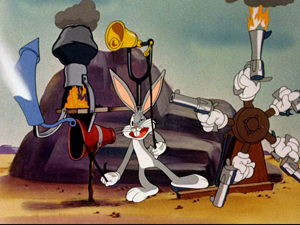
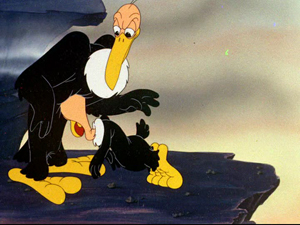
This is the disc for me! Bob Clampett is my favorite of the Looney Tunes directors.
The common axiom about Clampett is that, in his cartoons, even the drawings are funny. There is truth in that. Particularly as his style developed, the look of things got increasingly round (as opposed, to say, Chuck Jones' more angular work), and his characters were more rubbery, able to contort into any exaggeration (he was as much a master of the double-take as Tex Avery). For me, Clampett is more outrageous, more liable to do anything.
This DVD brings together a selection from the breadth of his Warners career. Again, it would have been nice to see this arranged chronologically, just to see how the director's signature aesthetic morphed over time, but even without that, it's pretty easy to tell that the handful of black-and-white shorts are earlier, and that the more developed look of cartoons like "The Old Grey Hare"--where we see Bugs and Elmer as not just old men, but babies, as well--come later. Clampett primarily works with three of the big characters: Porky (who stars in all of the black-and-white pictures), Daffy, and Bugs. He also does a couple of the gag strips that string together jokes based around a single idea, such as the world tour of "Crazy Cruise" and the barnyard antics of "Farm Frolics."
Two of the gems on this disc are the ones that aren't as locked into the franchise characters, however. One of my all-time favorites is "The Bashful Buzzard," about the overly shy vulture sent out by his mother to fetch some food. The bird, who carries the unlikely name of "Killer," hums to himself as he bumbles through the animal kingdom, ultimately settling on prey that is bigger than he thinks.
The other is "A Tale of Two Kitties," an early Tweety cartoon (he wasn't even yellow yet) that sees the tiny bird being chased by two cats who bear a striking resemblance to Abbott and Costello.
DVD 3 of Looney Tunes - Golden Collection, Volume Five is a real treat, funny from start to finish.
The full list of cartoons on DVD 3:
* Bacall to Arms (commentary by historian Jerry Beck) * Buckaroo Bugs (two commentaries: (1) historian Michael Barrier with audio of Bob Clampett; (2) directors John Kricfalusi and Eddie Fitzgerald, cartoonist Kali Fontecchio) * Crazy Cruise * Farm Frolics (commentary by voice actor Keith Scott) * Hare Ribbin' * Patient Porky * Prehistoric Porky * The Bashful Buzzard (commentary by writer Paul Dini) * The Old Gray Hare (commentary by filmmaker Greg Ford) * The Wacky Wabbit (commentary by director Eric Goldberg) * The Wise Quacking Duck * Wagon Heels * The Daffy Doc (commentary by animator Mark Kausler) * A Tale of Two Kitties (commentary by historian Michael Barrier with audio of Bob Clampett) * Porky's Pooch
***DISC 4: Early Daze***
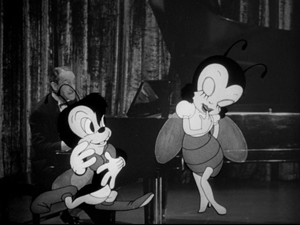
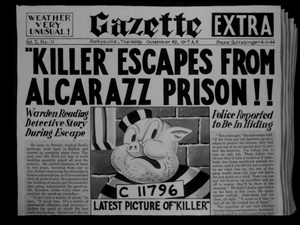
For the final disc of the set, we actually go backwards to the beginning. The fifteen cartoons on this DVD are from 1942 and earlier, predating the Looney Tunes' switch to color. We get several more Clampett cartoons here, as well as some by Frank Tashlin and Tex Avery, and 1936's "Alpine Antics," directed by Jack King.
What I usually like about earlier cartoons is how adventurous they tend to be. Not yet knowing what the medium was fully capable of, the pioneering animators who helmed these shorts seemed willing to try anything. This leads to a lot of inventive visuals and even more surreal gags, such as Beans digging straight down the center of the mountain in "Gold Diggers of '49." Once he reaches the bottom, the mountain's base becomes a slot machine, making it a true gamble whether or not he will find treasure.
A lot of these shorts have a heavier focus on music, such as "I've Got to Sing a Torch Song" and "Porky at the Crocadero." (Porky is the main franchise character represented here, along with a couple of appearances from Daffy.) Bob Clampett's "Eatin' on the Cuff, or The Moth Who Came to Dinner" isn't just driven by a jazzy piano number, but the pianist appears on screen, performing alongside the insects he sings about in an early experiment with combining live action footage and animation. It's pretty impressive.
Despite the more innocent air that permeates a lot of these cartoons, it should be noted that the shorts on this disc tend to have more racist stereotypes than on the others (DVD 3 has several, as well). "Gold Diggers," for instance, has a pair of Asian prospectors speaking in gibberish until a puff of smoke turns them to blackface, whereupon they start talking like a caricature of African Americans from the South. Or there's "Scrap Happy Daffy," a typical wartime piece with exaggerated images of the Japanese.
I know some people grow weary of the almost obligatory mention of such issues in reviews like this, but I think it's only fair to warn potential consumers of what is in store for them. Yet, as always, a set like this is about historical preservation, and we can't be secure in where we are if we don't look at where we came from. Plus, as adults in a progressive society, one hopes we can set aside such errors of the past and enjoy the cartoons for the incredible craft that is being showcased.
The full list of cartoons on DVD 4:
* Alpine Antics * Eatin' on the Cuff, or the Moth Who Came to Dinner (commentary by historian Jerry Beck) * Milk and Money * I've Got to Sing a Torch Song * Porky at the Crocadero (commentary by historian Daniel Goldmark) * Polar Pals * Scrap Happy Daffy (commentary by filmmaker Greg Ford) * Porky's Double Trouble * Gold Diggers of '49 * Pilgrim Porky * Wise Quacks * Porky's Preview (commentary by filmmaker Greg Ford) * Porky's Poppa * Wholly Smoke (commentary by historian Daniel Goldmark) * What Price Porky
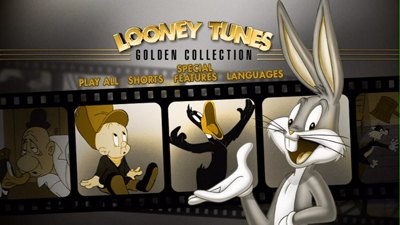
THE DVD
Video:
All the cartoons are presented in full frame. As I've noted, these are mainly fairly good. They've been cleaned up and the vibrant colors mostly restored to their original look. Some glitches in the cartoons remain, but more problems from the actual production end and less a problem with DVD manufacturing. Some of the scratches and dirt could maybe have been removed had there been a larger restoration effort made, but honestly, I'd say such issues only afflict about 1/3 of the shorts.
Sound:
The cartoons are mixed in mono, but the sound quality is solid and free of hiss or off-note tones. Unlike previous sets, there are no alternate language tracks, audio or subtitles. Only English audio and English subtitles for the deaf and hearing impaired.
Extras:
Each DVD on Looney Tunes - Golden Collection, Volume Five has its own unique extras. Many of the cartoons have alternate audio tracks, including tracks where the music and the effects work is isolated and audio commentaries by contemporary animators and historians. You can see which cartoons have what extra tracks by looking at the lists above. I have indicated which titles and what your choices are. All of the commentators are ones we know from previous sets, so no surprises, nothing new to report. All are usually informative, with the historians and critics being particularly good at sharing information about the production of each short. Some even use clips from old interviews from people involved, such as Greg Ford's recordings of Friz Freleng on DVD 2's "Red Riding Hoodwinked."
On all the DVDs, the cartoons can either be chosen one by one, or you can use the "play all" option to watch all the titles straight through. In order to access commentaries, you do have to go to the commentary menu, however; you can't just toggle into them with your audio button when watching each short.
DVD 1 has bonus features that keep in tune with the Bugs and Daffy theme. Several selections are taken from the old TV compilation program The Bugs Bunny Show: new bridging sequences for "Bad Time Story," a chance to eavesdrop on the audio for the recording sessions for "What's Up, Dog?" (complete with photo gallery), and a collection of fourteen commercials from the show, introduced by Jerry Beck. These commercials aren't just promos for the actual program, but also feature the characters hawking the products of the show's sponsors. Granted, these choices might have been better had they actually related to specific cartoons on the disc, but given that most Looney Tunes fans are completists, you're going to want these pieces from the TV show regardless. Also, note that though the series was broadcast in black-and-white, a few of the elements are in color.
A 2000 documentary called Chuck Jones: Extremes and In-Betweens, a Life in Animation is spread across DVD 1 and DVD 2. The first half is 39 minutes long, the second is 47 minutes, 30 seconds. The show's first part starts with his early life, working through his evolution at Warner Bros., and the characters he was associated with (and often created), and then part 2 goes into Jones' directorial style, the people he worked with, the more experimental cartoons he eventually made, and his post-Warners life. Jones participates, as does his brother, wife, and daughter, and there are also interviews with other animators from the time, critics and historians, and admirers as diverse as documentarian Ken Burns, Simpsons-creator Matt Groening, actors Whoopi Goldberg and Robin Williams, movie directors Ron Howard and Steven Spielberg, Saturday Night Live producer Lorne Michaels, composer Andre Previn, and Pixar's John Lasseter. A liberal dose of clips are shown, as is archival art.
DVD 2 also has a 2002 thirteen-minute Jones-related short called "A Chuck Jones Tutorial: Tricks of the Cartoon Trade." This is cut together using the same interviews as in the larger program.
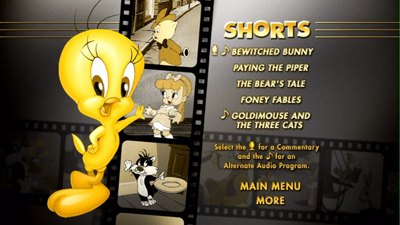
In addition to the Jones documentaries, the Fairy Tales disc also has two "Behind the Tunes" shorts created specifically for this DVD, "Once Upon a Looney Tune" and "Drawn to Life: The Art of Robert McKimson." These mini-documentaries are part of the series of featurettes made especially for the Golden Collections, and there are other installments of them on all the discs; they usually tend to somehow relate to the disc's theme. So, obviously, "Once Upon a Time" is about the various Warner Bros. takes on the familiar fairy tales, and it features the usual commentators, as well as folks like writer Mark Evanier, the guy who currently does the voice of Bullwinkle, and special effects pioneer Ray Harryhausen. This featurette actually shows a brief clip of the infamous "Coal Black," which is one they have yet to put on disc due to its rampant racial stereotyping.
The McKimson doc' celebrates an often unsung Looney Tunes director, and it features an interview with the animator's son and a lot of McKimson's production art. It's the lengthier of the two, clocking in at nearly 17 minutes, while "Once Upon..." is about 12 minutes.
DVD 3 has two more of the "Behind the Tunes" featurettes, each just over 9 minutes. The first is the fascinating "Wacky Warner One-Shots," looking at all the one-time-only cartoons made over the years, the assignments that allowed the directors to stretch their legs and try something different. The clips they show make me wish that there was a disc or two devoted to just these oddities!
The second documentary is "Real American Zero: The Adventures of Private SNAFU," an explanation of the wartime effort that saw the studio creating instructional cartoons exclusively for the U.S. Army. Many of these were directed by Bob Clampett, so it makes sense that this is on the disc devoted to his oeuvre. This feature also leads directly into the "From the Vault" feature, unearthing rarely seen cartoons as bonus material. In this case, we get two Private SNAFU shorts, "Coming!! SNAFU" and "Gripes." To go along with these, we also get three of the Navy equivalent cartoons starring Mr. Hook: "The Good Egg," "The Return of Mr. Hook," and "Tokyo Woes." (Note: These cartoons are not restored at all, so image and audio are both of sub-par quality.)
The Vault on DVD3 is rounded out by three more pieces of animation that connect directly to the shorts in the main program. First is Clampett's original cut of "Hare Ribbin'," which features Bugs shooting the dog, rather than the dog committing suicide. An incomplete storyboard reel has been compiled to show some of the original design for "The Bashful Buzzard," demonstrating the development process and how some gags changed from conception to final product. A one-minute alternate music cue for the opening of "The Bashful Buzzard" is also included, along with recreated title cards for what would have been the initial look of the cartoon's pre-Blue Ribbon beginning.
Finally, Greg Ford hosts six-minutes of previously unreleased audio composed by Milt Franklin as possible new theme music for the Merrie Melodies cartoons for the 1960s.
The lead extra on DVD 4 is the twenty-minute "Unsung Heroes: A Directors' Tribute." This new featurette looks at some of the directors from the earliest days of the Warners studio who did not move on to the later eras. Subjects include Harmon & Ising, Jack King, Ub Iwerks, Ben Hardaway (Bugs Bunny's namesake), Norm McKabe, and Art Davis--all of whom had careers at other studios before and after their tenure at Warners. Many of these directors have work in the main program of DVD 4 (though more often just as animators rather than as head man), though I'd have liked to see some actual crossover of shorts discussed and shorts available for our viewing. "Unsung Heroes" is essentially a longer "Behind the Tunes" featurette, cut in the same way and using the same interviews with commentators.
The other extras on DVD 4 are three television specials, clocking in at 1 hour, 11 minutes all together. These three shows were each originally half-an-hour with commercials, about 23 minutes without. They are 1976's Bugs and Daffy's Carnival of the Animals, directed by Chuck Jones and featuring the rabbit and duck performing the Saint-Saens classical piece, accompanied by a live-action orchestra and new animation, including more experimental musical sequences; 1979's Bugs Bunny's Looney Christmas Tales, by Jones and Friz Freleng; and 1980's Bugs Bunny's Bustin' Out All Over, by Jones and Phil Monroe. I had assumed these would be compilation shows, so was pleasantly surprised to find that they were all original animation. Unfortunately, the later two weren't all that interesting to me. The cartooning and the writing aren't up to snuff. The Carnival of the Animals, on the other hand, is a fascinating take on the material, showing Chuck Jones' propensity for exploration.
Finally, we get trailers for the new Dennis the Menace live-action film, season one of The Smurfs, and the video game Looney Tunes Acme Arsenal, complete with cheat codes for all you overgrown kids who can't beat it on your own.
The four discs are held in a foldable cardboard case with plastic double-disc trays. This then slides into an embossed slipcase.
FINAL THOUGHTS:
Animation fans are going to definitely want Looney Tunes - Golden Collection, Volume Five, but, really, this is a set every film fan should have. Cartoons or no, the Warner Bros. animation team created some of the best film comedies of all time, maintaining a boisterous tone and an outrageous sense of humor that only seems to compound itself from short to short. A decent restoration job and excellent extras make the fifth Golden Collection an all-around awesome package. The fact that this deep into a series Warners can still make it exciting is the truest evidence of the quality of the material. Highly Recommended.
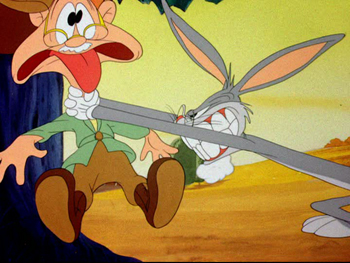
Jamie S. Rich is a novelist and comic book writer. He is best known for his collaborations with Joelle Jones, including the hardboiled crime comic book You Have Killed Me, the challenging romance 12 Reasons Why I Love Her, and the 2007 prose novel Have You Seen the Horizon Lately?, for which Jones did the cover. All three were published by Oni Press. His most recent projects include the futuristic romance A Boy and a Girl with Natalie Nourigat; Archer Coe and the Thousand Natural Shocks, a loopy crime tale drawn by Dan Christensen; and the horror miniseries Madame Frankenstein, a collaboration with Megan Levens. Follow Rich's blog at Confessions123.com.
|
| Popular Reviews |
| Sponsored Links |
|
|
| Sponsored Links |
|
|
| Release List | Reviews | Shop | Newsletter | Forum | DVD Giveaways | Blu-Ray | Advertise |
|
Copyright 2024 DVDTalk.com All Rights Reserved. Legal Info, Privacy Policy, Terms of Use,
Manage Preferences,
Your Privacy Choices | |||||||














